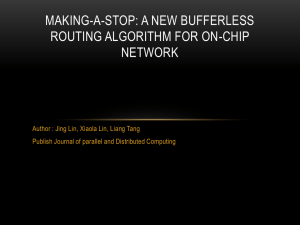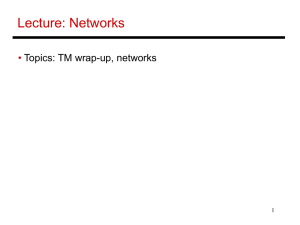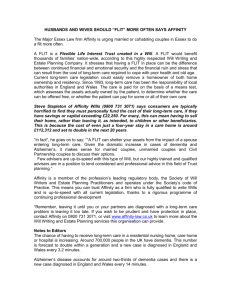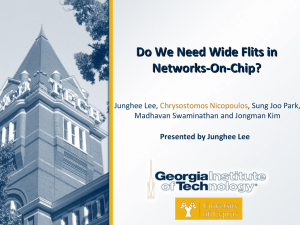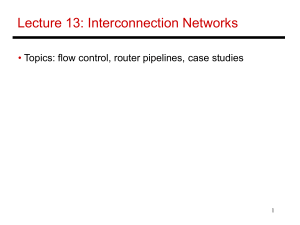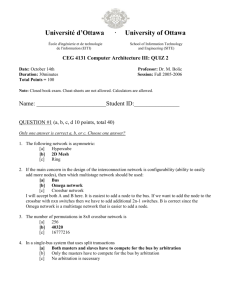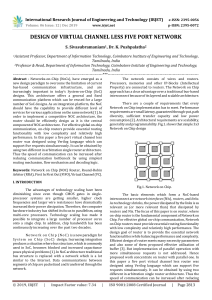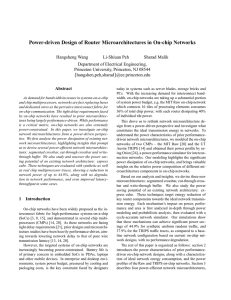Lecture 23: Interconnection Networks • Topics: Router microarchitecture, topologies 1
advertisement
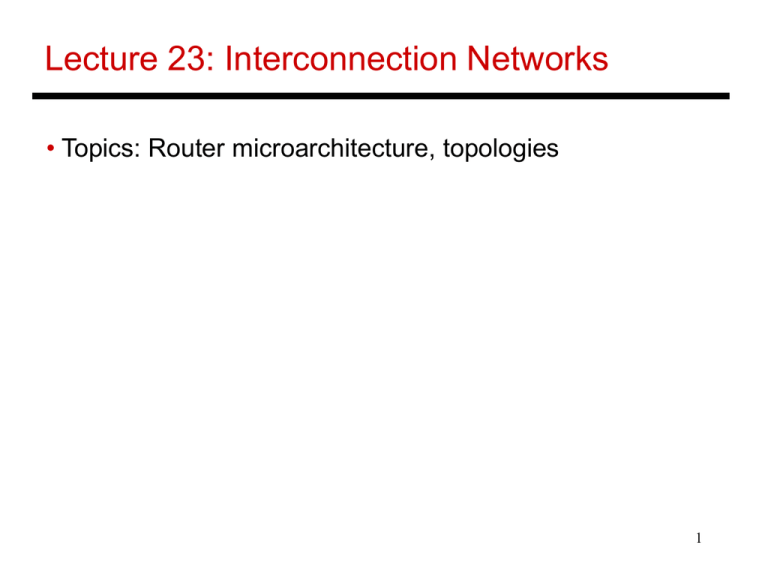
Lecture 23: Interconnection Networks • Topics: Router microarchitecture, topologies 1 Router Functions • Crossbar, buffer, arbiter, VC state and allocation, buffer management, ALUs, control logic, routing • The on-chip network can contribute 10-35% of total chip power; network delays can add tens of cycles to cache and memory access • Typical on-chip network power breakdown: 30% link 30% buffers 30% crossbar 2 Router Pipeline • Four typical stages: RC routing computation: the head flit indicates the VC that it belongs to, the VC state is updated, the headers are examined and the next output channel is computed (note: this is done for all the head flits arriving on various input channels) VA virtual-channel allocation: the head flits compete for the available virtual channels on their computed output channels SA switch allocation: a flit competes for access to its output physical channel ST switch traversal: the flit is transmitted on the output channel A head flit goes through all four stages, the other flits do nothing in the first two stages (this is an in-order pipeline and flits can not jump ahead), a tail flit also de-allocates the VC 3 Router Pipeline • Four typical stages: RC routing computation: compute the output channel VA virtual-channel allocation: allocate VC for the head flit SA switch allocation: compete for output physical channel ST switch traversal: transfer data on output physical channel Cycle Head flit Body flit 1 Body flit 2 Tail flit 1 2 3 4 5 6 RC VA SA ST -- --- RC VA SA SA ST SA ST --- STALL 7 -- SA ST -- SA ST -- -- SA ST -- -- -- -- -- SA ST -- SA ST 4 Speculative Pipelines • Perform VA and SA in parallel • Note that SA only requires knowledge of the output physical channel, not the VC • If VA fails, the successfully allocated channel goes un-utilized Cycle 1 2 Head flit RC VA ST SA Body flit 1 Body flit 2 Tail flit -- 3 4 5 6 7 RC SA ST -- • Perform VA, SA, and ST in parallel (can cause collisions and re-tries) • Typically, VA is the critical path – can possibly perform SA and ST sequentially SA ST SA ST -- VA SA ST SA ST SA ST SA ST • Router pipeline latency is a greater bottleneck when there is little contention • When there is little contention, speculation will likely work well! • Single stage pipeline? 5 Current Trends • Growing interest in eliminating the area/power overheads of router buffers; traffic levels are also relatively low, so virtual-channel buffered routed networks may be overkill • Option 1: use a bus for short distances (16 cores) and use a hierarchy of buses to travel long distances • Option 2: hot-potato or bufferless routing 6 Centralized Crossbar Switch P0 P1 P2 P3 P4 P5 P6 P7 7 Crossbar Properties • Assuming each node has one input and one output, a crossbar can provide maximum bandwidth: N messages can be sent as long as there are N unique sources and N unique destinations • Maximum overhead: WN2 internal switches, where W is data width and N is number of nodes • To reduce overhead, use smaller switches as building blocks – trade off overhead for lower effective bandwidth 8 Switch with Omega Network 000 P0 000 001 P1 001 010 P2 010 011 P3 011 100 P4 100 101 P5 101 110 P6 110 111 P7 111 9 Omega Network Properties • The switch complexity is now O(N log N) • Contention increases: P0 P5 and P1 P7 cannot happen concurrently (this was possible in a crossbar) • To deal with contention, can increase the number of levels (redundant paths) – by mirroring the network, we can route from P0 to P5 via N intermediate nodes, while increasing complexity by a factor of 2 10 Tree Network • Complexity is O(N) • Can yield low latencies when communicating with neighbors • Can build a fat tree by having multiple incoming and outgoing links P0 P1 P2 P3 P4 P5 P6 P7 11 Bisection Bandwidth • Split N nodes into two groups of N/2 nodes such that the bandwidth between these two groups is minimum: that is the bisection bandwidth • Why is it relevant: if traffic is completely random, the probability of a message going across the two halves is ½ – if all nodes send a message, the bisection bandwidth will have to be N/2 • The concept of bisection bandwidth confirms that the tree network is not suited for random traffic patterns, but for localized traffic patterns 12 Distributed Switches: Ring • Each node is connected to a 3x3 switch that routes messages between the node and its two neighbors • Effectively a repeated bus: multiple messages in transit • Disadvantage: bisection bandwidth of 2 and N/2 hops on average 13 Distributed Switch Options • Performance can be increased by throwing more hardware at the problem: fully-connected switches: every switch is connected to every other switch: N2 wiring complexity, N2 /4 bisection bandwidth • Most commercial designs adopt a point between the two extremes (ring and fully-connected): Grid: each node connects with its N, E, W, S neighbors Torus: connections wrap around Hypercube: links between nodes whose binary names differ in a single bit 14 Topology Examples Hypercube Grid Torus Criteria 64 nodes Performance Bisection bandwidth Cost Ports/switch Total links Bus Ring 2Dtorus 6-cube Fully connected 1 2 16 32 1024 1 3 128 5 192 7 256 64 2080 15 k-ary d-Cube • Consider a k-ary d-cube: a d-dimension array with k elements in each dimension, there are links between elements that differ in one dimension by 1 (mod k) • Number of nodes N = kd (with no wraparound) Number of switches : Switch degree : Number of links : Pins per node : N 2d + 1 Nd 2wd Avg. routing distance: Diameter : Bisection bandwidth : Switch complexity : d(k-1)/2 d(k-1) 2wkd-1 (2d + 1)2 Should we minimize or maximize dimension? 16 Title • Bullet 17

